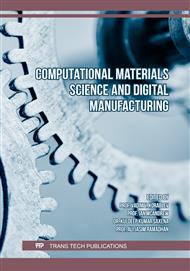[1]
M. Riahinezhad, M. Hallman and J.F. Masson: Buildings Vol. 11 (2021).
Google Scholar
[2]
J. Pašek: Advanced Materials Research Vol. 1041 (2014), p.87–91.
Google Scholar
[3]
A. Patil, A. Patel and R. Purohit: Materials Today: Proceedings Vol. 4 (2017), p.3807–3815.
Google Scholar
[4]
A. Simpson, I.G. Rattigan, E. Kalavsky, G. Parr: Cellular Polymers Vo. 39 (2020), p.238–262.
DOI: 10.1177/0262489320934263
Google Scholar
[5]
B.T. Ho, T.K. Roberts and S. Lucas: Critical Reviews in Biotechnology Vol. 38 (2018), p.308–320.
Google Scholar
[6]
A.N. Uttaravalli, S. Dinda and B.R. Gidla: Process Safety and Environmental Protection Vol. 137 (2020), p.140–148.
DOI: 10.1016/j.psep.2020.02.023
Google Scholar
[7]
M. la Gennusa, et al.: Sustainability Vol. 9 (2017).
Google Scholar
[8]
H. Rajabinejad, I.-I. Buciscanu and S.S. Maier: Environmental Engineering and Management Journal Vol. 18 (2019), p.1439–1456.
Google Scholar
[9]
B., Abu-Jdayil, A.-H. Mourad, W. Hittini, M. Hassan and S. Hameedi: Construction and Building Materials Vol. 214 (2019), p.709–735.
DOI: 10.1016/j.conbuildmat.2019.04.102
Google Scholar
[11]
S.K. Ramamoorthy, M. Skrifvars and A. Persson: Polymer Reviews Vol. 55 (2015), p.107–162.
Google Scholar
[12]
H.-R. Kymäläinen and A.-M. Sjöberg: Building and Environment Vol. 43 (2008), p.1261–1269.
Google Scholar
[13]
F.M. AL-Oqla, S.M. Sapuan and M. Jawaid: Journal of Natural Fibers Vol. 13 (2016), p.651–659.
Google Scholar
[14]
C. Buratti, E. Belloni, E. Lascaro, F. Merli and P. Ricciardi: Construction and Building Materials Vol. 171 (2018), p.338–349.
DOI: 10.1016/j.conbuildmat.2018.03.089
Google Scholar
[15]
V. Guna et al.: Journal of Natural Fibers Vol. 18 (2021), p.1871–1881.
Google Scholar
[16]
Food and Agriculture Organization of the United Nations (FAO), 2014. Africa Sustainable Livestock 2050, Country Brief Egypt. Financial support provided by the United States Agency for International Development (USAID) 2014.
Google Scholar
[17]
ASTM C518-21, 2021. ASTM C518 -21 – Standard Test Method for Steady-State Thermal Transmission Properties by Means of the Heat Flow Meter Apparatus. Standard Note.
DOI: 10.1520/c0518
Google Scholar
[18]
EDANA NWSP 120.4.R1, 2021. NWSP 120.4.R1 - Determination of Compression and Recovery of Highloft Nonwoven Fabrics Using Weights and Plates. Method 1: at room temperature.
Google Scholar
[19]
Rebolledo, P., Cloutier, A., Yemele, M.-C., 2018. Effect of Density and Fiber Size on Porosity and Thermal Conductivity of Fiberboard Mats. Fibers 6, 81.
DOI: 10.3390/fib6040081
Google Scholar
[20]
M. Riahinezhad, M. Hallman and J-F. Masson, Buildings Vol. 11, 7 (2021).
Google Scholar
[21]
R. Pennacchio et al.: Energy Procedia Vol. 111 (2017).
Google Scholar
[22]
D. Bhattacharyya and N.K. Kim: 21st International Conference on Composite Materials Xi'an, China, (2017).
Google Scholar
[23]
N.K. Kim, R.J.T. Lin, and D. Bhattacharyya: Composites Part A: Applied Science and Manufacturing Vol. 100 (2017), p.215–226.
Google Scholar
[24]
van Amber et al.: Textile Research Journal Vol. 85 (2015), p.26–35.
Google Scholar
[25]
H.L. Bos et al.: Journal of Materials Science Vol. 39 (2004), p.2159–2168.
Google Scholar



